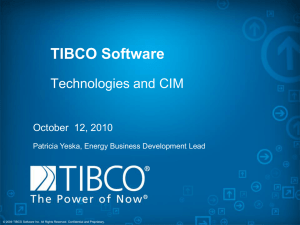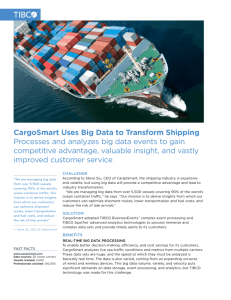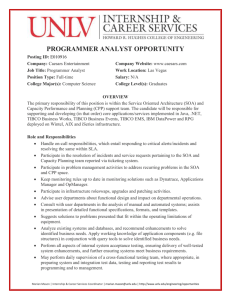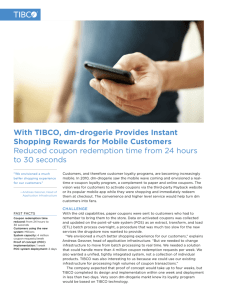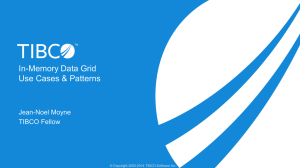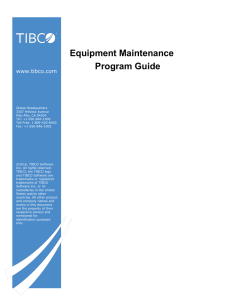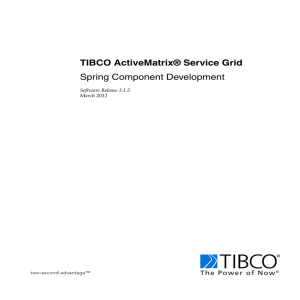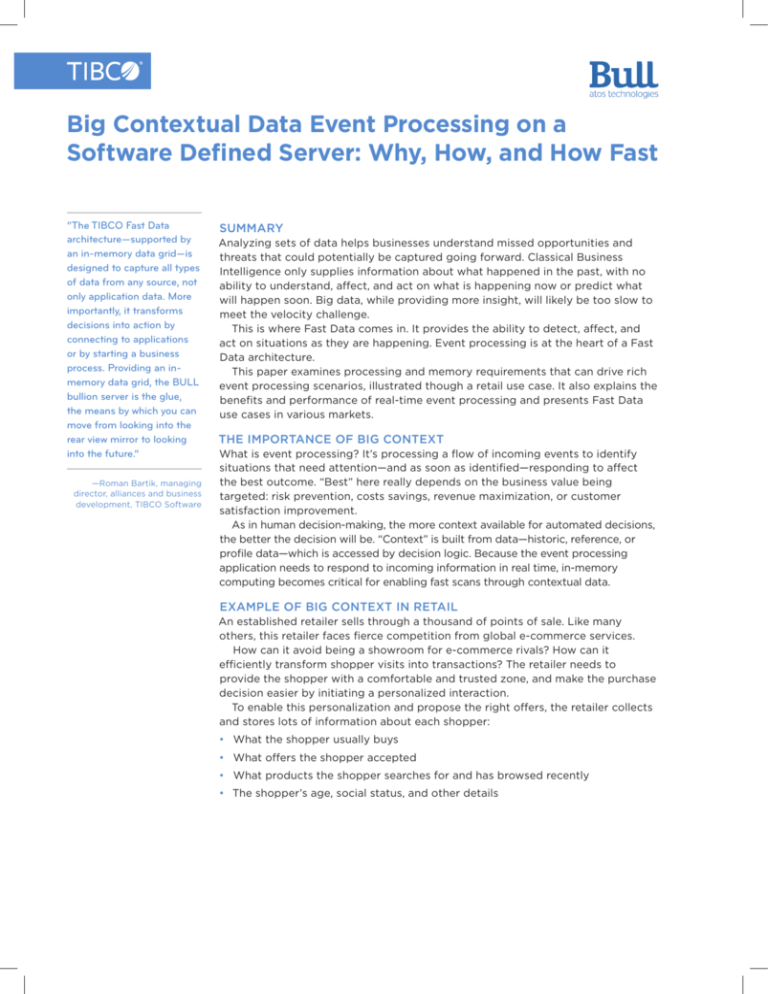
Big Contextual Data Event Processing on a
Software Defined Server: Why, How, and How Fast
“The TIBCO Fast Data
architecture—supported by
an in-memory data grid—is
designed to capture all types
of data from any source, not
only application data. More
importantly, it transforms
decisions into action by
connecting to applications
or by starting a business
process. Providing an inmemory data grid, the BULL
bullion server is the glue,
the means by which you can
move from looking into the
rear view mirror to looking
into the future.”
—Roman Bartik, managing
director, alliances and business
development, TIBCO Software
SUMMARY
Analyzing sets of data helps businesses understand missed opportunities and
threats that could potentially be captured going forward. Classical Business
Intelligence only supplies information about what happened in the past, with no
ability to understand, affect, and act on what is happening now or predict what
will happen soon. Big data, while providing more insight, will likely be too slow to
meet the velocity challenge.
This is where Fast Data comes in. It provides the ability to detect, affect, and
act on situations as they are happening. Event processing is at the heart of a Fast
Data architecture.
This paper examines processing and memory requirements that can drive rich
event processing scenarios, illustrated though a retail use case. It also explains the
benefits and performance of real-time event processing and presents Fast Data
use cases in various markets.
THE IMPORTANCE OF BIG CONTEXT
What is event processing? It’s processing a flow of incoming events to identify
situations that need attention—and as soon as identified—responding to affect
the best outcome. “Best” here really depends on the business value being
targeted: risk prevention, costs savings, revenue maximization, or customer
satisfaction improvement.
As in human decision-making, the more context available for automated decisions,
the better the decision will be. “Context” is built from data—historic, reference, or
profile data—which is accessed by decision logic. Because the event processing
application needs to respond to incoming information in real time, in-memory
computing becomes critical for enabling fast scans through contextual data.
EXAMPLE OF BIG CONTEXT IN RETAIL
An established retailer sells through a thousand of points of sale. Like many
others, this retailer faces fierce competition from global e-commerce services.
How can it avoid being a showroom for e-commerce rivals? How can it
efficiently transform shopper visits into transactions? The retailer needs to
provide the shopper with a comfortable and trusted zone, and make the purchase
decision easier by initiating a personalized interaction.
To enable this personalization and propose the right offers, the retailer collects
and stores lots of information about each shopper:
• What the shopper usually buys
• What offers the shopper accepted
• What products the shopper searches for and has browsed recently
• The shopper’s age, social status, and other details
TECHNICAL BRIEF | 2
“Data is now the power
that fuels business. But
to convert this abundant
raw energy into concrete
benefits, you need a
chain of expertise. You
need to understand the
information you’re dealing
with, choose and implement
the best technology, and
learn to identify business
challenges—all while
ensuring the necessary
performance and security.
As an integrated operator,
we master all the links
in the chain, from data
infrastructure to data
management. That’s Bull’s
great strength.”
— Arnaud Bertrand, executive
vice president at Bull,
an Atos company
TIBCO BusinessEvents is a
complex event processing (CEP)
solution that abstracts and
correlates meaningful business
information from the events
and data circulating through
your information systems. By
detecting patterns within the
real-time flow of events, it can
help you detect and understand
unusual activity, as well as
recognize trends, opportunities,
and problems. Publishing
business-critical information
in real time to your enterprise
systems or dashboards, you
can visually see and understand
what’s happening in the
moment and facilitate proactive
decision-making.
Each bit of information makes the personalization richer. Multiplied by millions of
individual shoppers, the data rapidly adds up, requiring large data space capacity.
Another key concern for any retailer is managing its stock efficiently and
being able to cross check customer information against product inventory across
different locations and sales channels.
All this data, as rich as it can be, is however useless if you can’t collect and
aggregate streams of shopper events, correlate them with contextual data, and
make rapid decisions while the window of opportunity is still open:
• Event: Shopper comes into the shop and requests information about product A.
• Context: Shopper has lots of loyalty points. Product B, the same type as
product A but with enhancements and a higher price, is over-inventory.
• Decision: Offer product B at the same price as product A with a debit of X
loyalty points.
This example shows typical detection and action logic for a retailer. A real
production system will have to detect and act upon dozens to hundreds of similar
types of situations.
Having hundreds of rules executing in milliseconds to seconds and scanning
terabytes of data leaves no other technical choice than storing data in memory.
Therefore, data space directly translates into memory space.
HARDWARE PLATFORMS AND BIG MEMORY
There are typically two ways to scale in-memory applications: horizontally
and vertically.
HORIZONTAL SCALING
Horizontal scaling—using the combined storage of dozens of small machines —works
well if you can co-locate data with the logic that uses it. When this co-location isn’t
possible, you need cross-node communication to find and access the data, which
adds traffic that impacts performance and may limit scalability.
If this is the scenario, vertical scalability using large, modern CPU and memory,
like the bullion from Bull, may provide a better option. It simplifies application
development and management because data and work do not need to
be partitioned.
VERTICAL SCALING
Vertical scaling—adding processors and storage to individual nodes—allows you
to increase capacity on-the-fly, according to need. As an example, the bullion
server can be dynamically reconfigured to provide elastic scalability across 2 to
16 processors and 48 GB to 24 TB of memory. Additional memory or storage can
be hot deployed. This type of solution can be very affordable because you don’t
need to invest in huge capacity up front. In many situations, vertical scalability is
an easy choice for handling more complex rules and greater volumes of events.
I/O
I/O
I/O
I/O
TECHNICAL BRIEF | 3
EVENT PROCESSING ON BIG MEMORY
RESULTS: TEST 1,
DATA CREATION
• 5.4 million objects
created/second
• 120,000 events
processed/second
TEST 1
Real world benchmarks are critical for validating the true scalability of
any software and hardware combination. Bull and TIBCO tested TIBCO
BusinessEvents® complex event processing platform on bullion machines.
The first set of tests validated the amount of data that TIBCO BusinessEvents
can create and manage as one logical segment using large memory.
Two different methods were used:
1 Loading data objects from files in chunks of 5,000 objects, the full power of
the machine was used. It loaded the entire set of one billion objects at a rate
of 5.4 million objects created/second. This benchmark describes the cold start
performance when data is loaded from other systems.
2 Creating one object when each event is received, representing a retail sales
transaction. Each object included about 30 columns. TIBCO BusinessEvents
processed 120,000 events/second, sustaining a flat processing rate until one
billion objects were created. This benchmark describes the performance the
system would deliver when managing up to one billion transaction records
or accounts.
RESULTS: TEST 2,
LARGE IN-MEMORY
DATASETS
• 32,447 events
processed/second
• Latency <1 ms
TEST 2
The next set of tests measured how efficiently the rules-based event processing
of TIBCO BusinessEvents can access and manipulate large in-memory datasets. A
simple scenario was used, where one rule would trigger for each event received,
and execute as follows:
• Get events from the TIBCO message bus (TIBCO Enterprise Message Service™)
• Parse event payload
• Get contextual data from in-memory grid or create it if not found
• Lock it
• Update/enrich the contextual data
• Send the response through the message bus
This action is similar to processing that checks a purchase against a customer
record and updates the record. Using three-quarters of machine resources, (one
quarter being left to the test drivers), TIBCO BusinessEvents processed at a rate
of 32,447 events/second with a processing latency under a millisecond.
RESULTS: TEST 3,
RULES EXECUTION
• Fewer rules executing:
40,000 operations/second,
limited by the network
• More rules executing:
3,500,000 rule evaluations/
second per CPU core
TEST 3
Last, we validated the performance of pure rules execution with a complex
configuration where many rules were evaluated for each incoming event.
Execution of one rule led to execution of another, with the total number varying.
For a low number of rules, the processing rate was limited by event delivery
capacity, reaching 40,000 operations/second. Increasing the number of rules
creates more CPU intensive processing. Network performance was less of
a concern. In this configuration, TIBCO BusinessEvents reached 3.5M rule
evaluations/second in each CPU core. This kind of multiple rule evaluation
is required in cross-sell or event-driven marketing applications, where many
potential offers are tested to find the best offer for a given customer interaction.
TECHNICAL BRIEF | 4
BULLION, THE
MOST ADVANCED
WORKSPACE FOR
FAST DATA
OTHER MARKETS THAT BENEFIT FROM BIG CONTEXTUAL DATA
With between 2 and 16 Intel Xeon
E7 v2 processors and up to 24
TB of memory, bullion provides
an x86 platform capable of
unmatched response, flexibility,
security—and especially
memory. Along with its reliability,
availability, and serviceability
(RAS) features, it cost-effectively
meets all challenges. You
can dynamically hot-deploy
resources like memory or I/O
thanks to a patented blade
design and reconfigure bullion
software-defined hardware for
on-demand capacity expansion
and unrivalled elasticity in
the face of changing needs.
Additionally bullion breaks the
Intel memory reference barriers
for extreme effectiveness in
memory-intensive environments.
• Telecommunications: An operator captures high volumes of events from its
network and customer care channels to assess the real-time state of network
elements correlated with customer data and interactions. The objective is to
provide the best service to customers and maximize efficiency of network
maintenance operations.
Previously, we used the example of a retailer to illustrate the need for big context,
but this need is certainly not limited to retail. A partial list of examples:
• Transportation: Airline companies hold passenger information, track their
reservations and luggage, and correlate with flight and scheduling information.
The objective is to react in the best way possible to unpredicted events to
continue to provide optimum service and minimized operations cost.
• Logistics: Hundreds of thousands of packages, each with different
characteristics and requirements, are tracked along their delivery paths,
through multiple partners, across multiple geographies.
• Internet of Things: A growing number of subscribers and devices, each sending
multiple types of information at a high frequency are tracked over a period
of time. The objective is to provide meaningful information, enough to detect
patterns and trigger alerts or corrective actions.
• Payments: Payments delivered through multiple channels and types of
payment instruments are aggregated to enrich intelligence on usage, help
prevent fraud, and create up-sell and cross-sell opportunities.
Bull, an Atos company, is the trusted operator for enterprise data. The Group, which is firmly established in the
Cloud and in Big Data, integrates and manages high-performance systems and end-to-end security solutions.
Bull’s offerings enable its customers to process all the data at their disposal, creating new types of demand.
Bull converts data into value for organizations in a completely secure manner. It currently employs around
9,200 people across more than 50 countries, with over 700 staff totally focused on R&D. In 2013, Bull recorded
revenues of €1.3 billion. For more information: http://www.bull.com/http://www.facebook.com/BullGroup/
http://twitter.com/bull_com
Global Headquarters
3307 Hillview Avenue
Palo Alto, CA 94304
+1 650-846-1000 TEL
+1 800-420-8450
+1 650-846-1005 FAX
www.tibco.com
TIBCO Software Inc. is a global leader in infrastructure and business intelligence software. Whether it’s
optimizing inventory, cross-selling products, or averting crisis before it happens, TIBCO uniquely delivers the
Two-Second Advantage®— the ability to capture the right information at the right time and act on it preemptively
for a competitive advantage. With a broad mix of innovative products and services, customers around the world
trust TIBCO as their strategic technology partner. Learn more about TIBCO at www.tibco.com.
©2014–2015, TIBCO Software Inc. All rights reserved. TIBCO, the TIBCO logo, TIBCO Software, Two-Second Advantage, TIBCO BusinessEvents, and TIBCO
Enterprise Message Service are trademarks or registered trademarks of TIBCO Software Inc. or its subsidiaries in the United States and/or other countries. All
other product and company names and marks in this document are the property of their respective owners and mentioned for identification purposes only.
03/03/15

